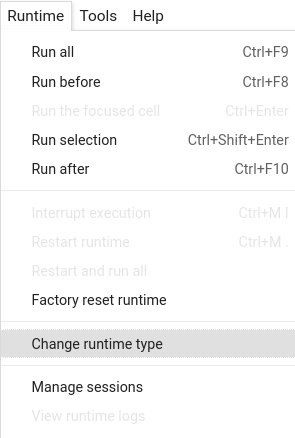Build a QA System Without Elasticsearch
Haystack provides alternatives to Elasticsearch for developing quick prototypes.
You can use an InMemoryDocumentStore or a SQLDocumentStore(with SQLite) as the document store.
If you are interested in more feature-rich Elasticsearch, then please refer to the Tutorial 1.
Prepare environment
Colab: Enable the GPU runtime
Make sure you enable the GPU runtime to experience decent speed in this tutorial. Runtime -> Change Runtime type -> Hardware accelerator -> GPU

You can double check whether the GPU runtime is enabled with the following command:
%%bash
nvidia-smi
To start, install the latest release of Haystack with pip:
%%bash
pip install --upgrade pip
pip install git+https://github.com/deepset-ai/haystack.git#egg=farm-haystack[colab]
Logging
We configure how logging messages should be displayed and which log level should be used before importing Haystack. Example log message: INFO - haystack.utils.preprocessing - Converting data/tutorial1/218_Olenna_Tyrell.txt Default log level in basicConfig is WARNING so the explicit parameter is not necessary but can be changed easily:
import logging
logging.basicConfig(format="%(levelname)s - %(name)s - %(message)s", level=logging.WARNING)
logging.getLogger("haystack").setLevel(logging.INFO)
Document Store
# In-Memory Document Store
from haystack.document_stores import InMemoryDocumentStore
document_store = InMemoryDocumentStore()
# Alternatively, uncomment the following to use the SQLite Document Store:
# from haystack.document_stores import SQLDocumentStore
# document_store = SQLDocumentStore(url="sqlite:///qa.db")
Preprocessing of documents
Haystack provides a customizable pipeline for:
- converting files into texts
- cleaning texts
- splitting texts
- writing them to a Document Store
In this tutorial, we download Wikipedia articles on Game of Thrones, apply a basic cleaning function, and index them in Elasticsearch.
from haystack.utils import clean_wiki_text, convert_files_to_docs, fetch_archive_from_http
# Let's first get some documents that we want to query
# Here: 517 Wikipedia articles for Game of Thrones
doc_dir = "data/tutorial3"
s3_url = "https://s3.eu-central-1.amazonaws.com/deepset.ai-farm-qa/datasets/documents/wiki_gameofthrones_txt3.zip"
fetch_archive_from_http(url=s3_url, output_dir=doc_dir)
# convert files to dicts containing documents that can be indexed to our datastore
# You can optionally supply a cleaning function that is applied to each doc (e.g. to remove footers)
# It must take a str as input, and return a str.
docs = convert_files_to_docs(dir_path=doc_dir, clean_func=clean_wiki_text, split_paragraphs=True)
# We now have a list of dictionaries that we can write to our document store.
# If your texts come from a different source (e.g. a DB), you can of course skip convert_files_to_dicts() and create the dictionaries yourself.
# The default format here is: {"name": "<some-document-name>", "content": "<the-actual-text>"}
# Let's have a look at the first 3 entries:
print(docs[:3])
# Now, let's write the docs to our DB.
document_store.write_documents(docs)
Initialize Retriever, Reader & Pipeline
Retriever
Retrievers help narrowing down the scope for the Reader to smaller units of text where a given question could be answered.
With InMemoryDocumentStore or SQLDocumentStore, you can use the TfidfRetriever. For more retrievers, please refer to the tutorial-1.
# An in-memory TfidfRetriever based on Pandas dataframes
from haystack.nodes import TfidfRetriever
retriever = TfidfRetriever(document_store=document_store)
Reader
A Reader scans the texts returned by retrievers in detail and extracts the k best answers. They are based on powerful, but slower deep learning models.
Haystack currently supports Readers based on the frameworks FARM and Transformers. With both you can either load a local model or one from Hugging Face’s model hub ( https://huggingface.co/models).
Here: a medium sized RoBERTa QA model using a Reader based on FARM ( https://huggingface.co/deepset/roberta-base-squad2)
Alternatives (Reader): TransformersReader (leveraging the pipeline of the Transformers package)
Alternatives (Models): e.g. “distilbert-base-uncased-distilled-squad” (fast) or “deepset/bert-large-uncased-whole-word-masking-squad2” (good accuracy)
Hint: You can adjust the model to return “no answer possible” with the no_ans_boost. Higher values mean the model prefers “no answer possible”
FARMReader
from haystack.nodes import FARMReader
# Load a local model or any of the QA models on
# Hugging Face's model hub (https://huggingface.co/models)
reader = FARMReader(model_name_or_path="deepset/roberta-base-squad2", use_gpu=True)
TransformersReader
Alternatively, we can use a Transformers reader:
# from haystack.nodes import FARMReader, TransformersReader
# reader = TransformersReader(model_name_or_path="distilbert-base-uncased-distilled-squad", tokenizer="distilbert-base-uncased", use_gpu=-1)
Pipeline
With a Haystack Pipeline you can stick together your building blocks to a search pipeline.
Under the hood, Pipelines are Directed Acyclic Graphs (DAGs) that you can easily customize for your own use cases.
To speed things up, Haystack also comes with a few predefined Pipelines. One of them is the ExtractiveQAPipeline that combines a retriever and a reader to answer our questions.
You can learn more about Pipelines in the
docs.
from haystack.pipelines import ExtractiveQAPipeline
pipe = ExtractiveQAPipeline(reader, retriever)
Voilà! Ask a question!
# You can configure how many candidates the reader and retriever shall return
# The higher top_k for retriever, the better (but also the slower) your answers.
prediction = pipe.run(
query="Who is the father of Arya Stark?", params={"Retriever": {"top_k": 10}, "Reader": {"top_k": 5}}
)
# You can try asking more questions:
# prediction = pipe.run(query="Who created the Dothraki vocabulary?", params={"Reader": {"top_k": 5}})
# prediction = pipe.run(query="Who is the sister of Sansa?", params={"Reader": {"top_k": 5}})
# Now you can either print the object directly...
from pprint import pprint
pprint(prediction)
# Sample output:
# {
# 'answers': [ <Answer: answer='Eddard', type='extractive', score=0.9919578731060028, offsets_in_document=[{'start': 608, 'end': 615}], offsets_in_context=[{'start': 72, 'end': 79}], document_id='cc75f739897ecbf8c14657b13dda890e', meta={'name': '454_Music_of_Game_of_Thrones.txt'}}, context='...' >,
# <Answer: answer='Ned', type='extractive', score=0.9767240881919861, offsets_in_document=[{'start': 3687, 'end': 3801}], offsets_in_context=[{'start': 18, 'end': 132}], document_id='9acf17ec9083c4022f69eb4a37187080', meta={'name': '454_Music_of_Game_of_Thrones.txt'}}, context='...' >,
# ...
# ]
# 'documents': [ <Document: content_type='text', score=0.8034909798951382, meta={'name': '332_Sansa_Stark.txt'}, embedding=None, id=d1f36ec7170e4c46cde65787fe125dfe', content='\n===\'\'A Game of Thrones\'\'===\nSansa Stark begins the novel by being betrothed to Crown ...'>,
# <Document: content_type='text', score=0.8002150354529785, meta={'name': '191_Gendry.txt'}, embedding=None, id='dd4e070a22896afa81748d6510006d2', 'content='\n===Season 2===\nGendry travels North with Yoren and other Night's Watch recruits, including Arya ...'>,
# ...
# ],
# 'no_ans_gap': 11.688868522644043,
# 'node_id': 'Reader',
# 'params': {'Reader': {'top_k': 5}, 'Retriever': {'top_k': 5}},
# 'query': 'Who is the father of Arya Stark?',
# 'root_node': 'Query'
# }
# ...or use a util to simplify the output
from haystack.utils import print_answers
# Change `minimum` to `medium` or `all` to control the level of detail
print_answers(prediction, details="minimum")
About us
This Haystack notebook was made with love by deepset in Berlin, Germany
We bring NLP to the industry via open source!
Our focus: Industry specific language models & large scale QA systems.
Some of our other work:
Get in touch: Twitter | LinkedIn | Discord | GitHub Discussions | Website
By the way: we’re hiring!